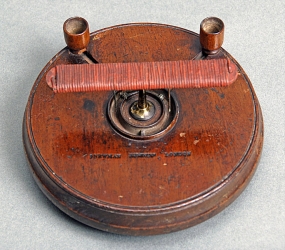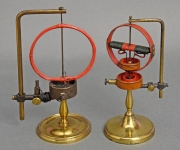Scientific Instrument Society 25th Anniversary Exhibition
Navigation:
<< First | < Previous | Next > | Last >>
50 Electrical Demonstration Apparatus
In 1820 the Danish physicist Hans Christian Oersted (1777-1851) discovered that a wire carrying an electric current can deflect a magnetic needle. In 1831 at the Royal Institution, London, Michael Faraday (1791-1867) discovered electro-magnetic induction, in which an electric current was induced in a coil of wire when a magnet was moved through it.
These crucial experiments led to a plethora of devices that demonstrated rotation caused by a current of electricity, and three very early examples are displayed here. Each design is associated with the Scotsman William Ritchie (1790-1837), who was Rector of The Royal Tain Academy, Ross-shire and later studied in Paris under Thenard, Gay-Lussac and Biot. He then moved to London and obtained a Professorship at the Royal Institution.
All three instruments would have been connected to a battery and the ends of their wires touched the surface of a mercury meniscus. (They are displayed here without their mercury.) Aligning the mercury division with the earth’s magnetic meridian could produce continuous rotation.
Ritchie described the first instrument (on the left) in 1833. It is an electro-magnet demonstration motor on a wooden base, signed ‘I Newman Regent St London’; John F Newman was active 1812-1856. Ritchie described a version of the second instrument (near right) in 1834. A very early form of electric motor dating from c.1835, it is based on the rotating electro-magnet seeking north and a commutator which would be filled with mercury to effect the reversal of the current every half turn. This would keep the electro-magnet rotating
In 1838 the instrument maker Charles William Collins (fl.1838-59) mounted two of Ritchie’s second instruments above each other, so that they rotated in opposite directions (far right). Collins may have made these two instruments as, although Watkins and Hill (fl.1819-56) illustrate both in their catalogue, they do not ascribe either. However, the double instrument has a paper label of the retailer, ‘F.T. HUDSON, Optician, Greenwich.’; this was Frederick T. Hudson (fl.1845).
Private Collection U.K. (wooden base, on the left)
Private Collection, West Midlands, U.K. (brass bases, on the right)
See: Philosophical Transactions of the Royal Society, 1833, pp. 319-320, Plate VII.
Philosophical Magazine, IV, 1834, pp. 13-14.
W. Sturgeon ed., Annals of Electricity, Magnetism and Chemistry, vol. 3, January 1839, pp. 426-427, Plate XII.
Watkins and Hill, Catalogue of Magnetic, Electro-Magnetic, Electro-Dynamic and Magneto-Electric Inductive Instruments and Apparatus. nd. (c.1845) Items 95, 96
P.D.
Objects lent by Anonymous Lender II, West Midlands, UK:
04. Beam Compass, by George Adams, London, 1757-60
13. Waywiser, by George Adams jr, London, between 1784 and 1796
35. Silver Engine-Turned Box Sextant, by Troughton, London, c. 1810
37. Sextant, by Jesse Ramsden, London, c.1765
42. Hydrostatic Balance, by George Adams, London, c. 1760
Objects lent by Anonymous Lender IV, UK:
22. Jet Cart, by Frances Watkins?, English, c. 1770
23. Frictional Electrostatic Generator, by John Newman, London, Early 19th Century
44. 'Gun-Barrel' Theodolite, by Jonathan Sisson, London, c. 1740
49. Electrostatic Cannon, by Thomas Jones, London, Early 19th Century


